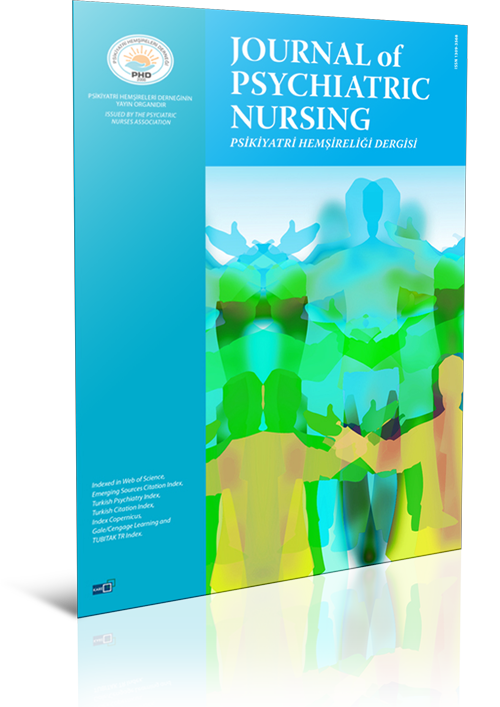
Volume: 11 Issue: 4 - 2020
| 1. | Frontmatter Pages I - III |
| EDITORIAL | |
| 2. | Editorial Fahriye Oflaz Page IV |
| QUALITATIVE RESEARCH | |
| 3. | Emotional closeness in neonatal intensive care units: A qualitative study Ayşe Gürol, Kadir Şerafettin Tekgündüz, Serap Ejder Apay, Süreyya Özdemir, Ramazan Güven doi: 10.14744/phd.2020.65668 Pages 261 - 267 INTRODUCTION: The aim of this study was to explore perceptions and experiences of mothers with regard to the barriers and facilitators to emotional closeness and mothers feelings of emotional closeness when their newborn infants are cared for in neonatal intensive care units. METHODS: This study applied a focus group methodology. The study group included a total of nine mothers who were staying in the Mother Room of the neonatal intensive care unit and agreed to participate in the study. For collection of data, a semi-structured emotional closeness form was administered through face-to-face interviews conducted with the participants in a suitable physical environment. A voice-recording device was used during the interviews. RESULTS: In this study, the mothers described the main barrier preventing them from feeling emotionally close to their newborn as the inability to touch and be with their newborn in the units. They defined emotional closeness as the mutual recognition achieved between mother and child through physical closeness. The mothers further emphasized the importance of being face-to-face and having eye contact with their child, and they believed that touching increased maternal feelings of emotional closeness, as it provided the reality that this was their baby. Breastfeeding was another feature highlighted by the mothers as being an activity that made them feel emotionally close to their newborn infants. DISCUSSION AND CONCLUSION: The findings from this study overall showed that when and how mothers feel emotionally close is grounded in the experiences and conditions that serve to either facilitate or debilitate emotional closeness. |
| RESEARCH ARTICLE | |
| 4. | Investigation of the relationship between internalized stigmatization and social loneliness in psychiatric inpatients Meryem Fırat, Burcu Demir Gökmen, Mine Cengiz doi: 10.14744/phd.2020.09226 Pages 268 - 274 INTRODUCTION: This study aimed to investigate the relationship between internalized stigmatization and social loneliness in psychiatric inpatients. METHODS: The study population consisted of all inpatients treated in the psychiatric ward of a research hospital in a province in the east of Turkey. There was no sample selection from the group of the 77 patients who received inpatient treatment at the psychiatry clinic between March 2017 and February 2018 and complied with the inclusion criteria. The Personal Information Form, Internalized Stigma in Mental Illness Scale, and Loneliness Scale were used to collect data by a face-to-face interview technique; the data were evaluated using the SPSS 23 package program. Percentage, mean, standard deviation, t test, Mann-Whitney U, Kruskal-Wallis, and correlation analysis were used for statistical analysis. RESULTS: In the correlation analysis of the scales, it was determined that there was a statistically negative relationship between the Stigma Resistance subdimension and loneliness, and a statistically significant positive correlation between the loneliness score, mean scores of Alienation, Approval of Stereotypes, Perceived Discrimination, Social Retraction and Resistance against Stigma. DISCUSSION AND CONCLUSION: Psychiatric patients may have a more isolated life because of internalized stigmatization. In this study, it was concluded that the level of loneliness increased as the internalized stigmatization levels of the patients increased, but that loneliness decreased as patients resisted internalized stigmatization. By decreasing the stigma and increasing the resistance to internalized stigma, patients can increase their adaptation to active social life. |
| 5. | Factors affecting mental status and effects of shift work system in healthcare workers Bahadır Geniş, Behcet Cosar, Mustafa Ender Taner doi: 10.14744/phd.2020.60590 Pages 275 - 283 INTRODUCTION: Shift work system causes many physical and mental health problems. This study aimed to investigate the effects of shift work on sleep quality, mental status, and quality of life of healthcare personnel. It also aimed to determine the population at risk for depression and anxiety disorders by assessing differences among the occupational groups. METHODS: This study was carried out with 219 healthcare personnel at Gazi University Hospital. Employees were classified according to their more recent working schedule (shift, non-shift) and occupational groups (doctor, nurse, and other). Beck Depression Inventory (BDI), Beck Anxiety Inventory (BAI), Pittsburg Sleep Quality Index (PSQI), Morningness-Eveningness Questionnaire (MEQ), Perceived Stress Scale (PSS), and Professional Quality of Life Scale (ProQOL) were administered to the employees. RESULTS: The BDI (p<0.000), BAI (p<0.001), PSS stress perception subscale (p=0.032), PSQI (p<0.001), and ProQOL burnout subscale (p<0.001) scores were significantly higher in shift personnel than non-shift personnel. When the participants were analyzed according to occupational groups, BAI scale scores were significantly higher in nurses (p=0.001) than doctors or others, whereas stress perception and burnout were significantly higher in physicians (p=0.003; p=0.005, respectively). There was no significant difference between the occupational groups in terms of BDI and occupational satisfaction (p=0.101; p=0.778, respectively). In the regression analysis, the most important predictor of the BDI and BAI score was working 41 hours or more. The most important predictor of the PSQI score was shift work. DISCUSSION AND CONCLUSION: According to these results, especially nurses and doctors working in shifts are at serious risk for depression, anxiety, and sleep disorders. Employees awareness should be increased regarding the associated risk of smoking, which is a risk factor. Health care workers should be trained in stress management and sleep hygiene to prevent the occurrence of mental illnesses. |
| 6. | Alexithymia in nurses and its relationship with burnout, anger, and somatization Ebru Konal Korkmaz, Sibel Telli, Hasibe Kadioglu, Semra Karaca doi: 10.14744/phd.2020.98700 Pages 284 - 291 INTRODUCTION: The aim of the study was to evaluate the alexithymia levels of nurses and the relationship between alexithymia and burnout, anger, and somatization. METHODS: This correlational descriptive study was conducted with 339 nurses working in four training research hospitals between February 3 and 28, 2014. Data were collected using the Demographic Questionnaire, Toronto Alexithymia Scale, Maslach Burnout Inventory, State-Trait Anger Expression Inventory, and SCl-90 somatization subscale. The analysis of the data was performed using descriptive statistics, the Mann-Whitney U test, Kruskal-Wallis test, and Spearman's correlation. RESULTS: The mean age of the nurses participating in the research was 30.8±7.3, 91.2% were female, and 28.6% (n=97) had moderate alexithymia. The alexithymic nurses had higher burnout (p<0.05), anger (p<0.01), and somatization (p<0.01) scores than those who did not exhibit alexithymia. A positive weak relationship was found between the alexithymia scores and burnout (r=0.18; p<0.01), anger (r=0.34; p<0.01), and somatization (r=0.32; p<0.01) scores. DISCUSSION AND CONCLUSION: The findings of the study showed that the level of alexithymia in nurses was high and the level of burnout, anger, and somatization increased as the alexithymia score increased. |
| 7. | The relationship between work-related variables, job satisfaction, and perceived professional autonomy of radiation oncology nurses in Turkey Şahika Mert, Emine Türkmen doi: 10.14744/phd.2020.03789 Pages 292 - 297 INTRODUCTION: This study analyzed the relationship between work-related variables, job satisfaction, and perceived professional autonomy in Turkish radiation oncology nurses. METHODS: This descriptive cross-sectional study was conducted with 138 radiation oncology nurses employed at university, public, and private hospitals. Data were collected using a data collection form that included demographic variables and the 30-item Nursing Activity Scale. Multiple logistic regression analysis was used to evaluate the impact of independent variables on the perceived professional autonomy and job satisfaction of nurses. RESULTS: The nurses perceptions of professional autonomy and job satisfaction were moderate. Experience, being a ward head/outpatient clinic nurse, and training affected the level of professional autonomy of nurses (OR: 2.90, 2.62, and 2.56, respectively). Additionally, the type of hospital, perceived level of professional autonomy, and position affected the level of job satisfaction (OR: 4.05, 3.23, and 2.35, respectively). DISCUSSION AND CONCLUSION: Radiation oncology nurses with a moderate level of professional autonomy and job satisfaction and those completing undergraduate and graduate education perceived lower levels of autonomy than other nurses did, indicating a significant clinical problem. It is recommended that healthcare and nursing directors increase radiation oncology nurses professional autonomy based on job requirements and responsibilities because low autonomy may cause job stress and burnout. |
| 8. | The relationship between self-esteem and perceived parenting styles of adolescents with cancer Naime Altay, Tuba Arpacı, Ebru Kılıçarslan Toruner doi: 10.14744/phd.2020.90377 Pages 298 - 305 INTRODUCTION: The development of self-esteem may be negatively affected in adolescents receiving cancer treatment and perceived parenting styles may also effect their self-esteem. This study aims to determine the relationship between adolescents self-esteem and perceived parenting styles. METHODS: The quantitative-descriptive study was conducted with 55 adolescents diagnosed with cancer between the ages of 12 and 18. The study was conducted in the Pediatric Hematology and Oncology Service at Gazi University Hospital between 01.11.201201.06.2014. Data were collected with a Descriptive Characteristics Form related to the adolescents and families, the Rosenberg Self-Esteem Scale(RSES), the Parenting Style Questionnaire (PSQ)Scale. RESULTS: Most of adolescents had a high self-esteem score (85.5%). When the adolescents perceptions of parenting styles were assessed, it was determined that 58.2% of the parents exhibited democratic behavior, and 41.8% exhibited permissive behavior. There was no significant correlation between the parenting style sub-scale scores and the self-esteem scores of the adolescents (p>0.05). DISCUSSION AND CONCLUSION: Self-esteem and perceived parenting styles of adolescents may have a significant impact on their adaptation to the illness. Therefore, assessing factors affecting the physical and psychological well-being of adolescents is an important part of nursing interventions. |
| 9. | Adherence to prescribed treatment by adolescent outpatients with mental disorders at a regional psychiatric hospital Gül Dikeç, Leyla Baysan Arabacı, Öznur Bilac doi: 10.14744/phd.2020.57855 Pages 306 - 314 INTRODUCTION: The aim of this study was to evaluate adherence to treatment by adolescents with mental disorders who applied to the child and adolescent psychiatry outpatient clinic of a regional psychiatric hospital. METHODS: This descriptive and cross-sectional study was conducted with 142 adolescents who were followed while attending the child and adolescent psychiatry outpatient clinic of a regional psychiatric hospital for twelve months between November 2018 and November 2019. They had been using psychotropic medications for at least three months. In this study, an Information Form with 31 open- and closed-ended questions was used to collect the data. Frequency, percentage, mean, and standard deviation were used to evaluate the data. RESULTS: In this study, 55.6% of the adolescents who participated were female, and the mean age was 14.51±1.98 years. 93.7% of adolescents continued their education and 70.4% lived in a nuclear family structure. Adolescents were followed up with Attention Deficit-Hyperactivity Disorder (ADHD), and the Anxiety, Mood, and Psychotic Disorders, respectively. Among them, 50.7% use stimulants, 50.7% use antidepressants, and antipsychotic medications. Adolescents used their medications regularly, most (50.7%) did not experience any side effects; those who experienced side effects more often used ineffective coping methods. 37.3% had no difficulty in remembering to take their medications and 24.6% did not forget to take them. Adolescents who found that using regular medication is important often stated that they did not give up whether they felt good or bad; they frequently used support and reminder systems (such as alarms or notes) to get their medications regularly. 61.3% of the adolescents stated that they always came to their appointments regularly; however, some stated that they could often interrupt their appointments in order not to miss classes. DISCUSSION AND CONCLUSION: It is recommended that mental health and psychiatric nurses perform experimental studies in different groups of adolescents with mental disorders, using a larger sample in which interventions increase the adherence with treatment, determine the factors affecting the adherence to treatment, and develop standard measurement tools. |
| 10. | Determining the relationships between adolescent subjective well-being, self-efficacy, social acceptance level, and irrational beliefs in adolescents Esma Kabasakal, Oya Nuran Emiroğlu doi: 10.14744/phd.2020.67044 Pages 315 - 322 INTRODUCTION: The research aims to examine the relationships between irrational thinking and subjective well-being, self-efficacy, and social acceptance of adolescents with disabilities. The study was designed as a descriptive and correlational study. METHODS: The research was conducted between October 25, 2017, and January 17, 2018, with 212 students. Data were collected using the Adolescent Irrational Belief Scale, Adolescent Subjective Well-being Scale, General Self-Efficacy Scale, and Social Acceptance Scale. The Spearman correlation coefficient was used in statistical analysis to determine the relationships and correlations. RESULTS: The level of irrational beliefs in adolescents revealed that there was a negative linear correlation between the subjective well-being level (r=-0.265), self-efficacy level (r=-0.265), and social acceptance of disability level (r=-0.162). Thus, the irrational belief levels of adolescents increased with decreasing levels of subjective well-being, self-efficacy, and social acceptance of disabled people. The results obtained from the social acceptance scale revealed that there was also a positive correlation between the subjective well-being (r=0.205) and self-efficacy (r=0.260) levels of adolescents. DISCUSSION AND CONCLUSION: Positive relationships between adolescents self-efficacy, subjective well-being, and social acceptance were determined in the study, while they had a negative relationship with irrational beliefs. The findings suggested that adolescents develop rational thinking skills that include philosophical items. |
| 11. | Examining the personality traits and life goals of nurses and teachers: The sample of Van Gamze Mukba, Zohre Kaya doi: 10.14744/phd.2020.05945 Pages 323 - 332 INTRODUCTION: This research was carried out to determine the relationship between the personality traits and life goals of nurses and teachers, as well as determining the differences between nurses and teachers in terms of personality traits and life goals. METHODS: This study was based on the relational screening model and consisted of 308 participants, 184 teachers and 124 nurses working in Van, Turkey during the 20152016 academic year. Study data were collected using a personal information form, the Life Goals Scale (LGS) and the Quick Big Five Personality Test (QBFPT). Correlation and two-way ANOVA technique were used to analyze the data. Normal distribution of the data was assessed by Kolmogorov-Smirnov analysis. RESULTS: According to the results of the research, there was a significant positive correlation between personality traits and life goals of teachers and nurses. According to the comparison between teachers and nurses, both occupation and occupational happiness had a significant effect on the emotional stability personality trait. There was a significant difference between the participants in terms of extrinsic life goals; the extrinsic life goals scores of the nurses were higher than those of the teachers. DISCUSSION AND CONCLUSION: The extrinsic life goals scores of the nurses were higher than those of the teachers; therefore, further research of nurses extrinsic motivations, extrinsic life goals and other variables affecting these sub-goals would be beneficial. The study illustrated that the teachers extraversion and emotional stability personality traits did not show any meaningful relationship with any subfactors of life goals. Consequently, the effects of teachers extraversion and emotional stability personality traits on life goals and occupational happiness can be demonstrated through qualitative and quantitative scientific studies |
| 12. | Investigation of the relationship between the level of perceived social support and healthy lifestyle behaviors of pregnant women Merve Kanığ, Kafiye Eroglu doi: 10.14744/phd.2020.89156 Pages 333 - 340 INTRODUCTION: This study was performed to determine the effects of perceived social support on the healthy lifestyle behaviors of pregnant women. METHODS: This descriptive study was conducted in a gestational outpatient clinic and a non-stress test room at a state hospital in Istanbul. The study sample included 329 literate pregnant women who did not suffer from any psychosocial issues or have any pregnancy related risks. The data were collected in face to face interviews using a Risk Assessment Form of the Turkish Ministry of Health, the Pregnant Women Identification Form, Multidimensional Scale of Perceived Social Support, and the Health Promotion Lifestyle Profile II. Statistical analyses of obtained data were analyzed with the descriptive statistics numbers, percentages and mean and correlation tests. RESULTS: In the study, 69% of the pregnant women were over 25 years of age, 65.7% had been married for 4 years or more, 56.6% were high school graduates or had a higher level of education, 75.4% had health insurance and 87.5% were unemployed. The mean score for the Multidimensional Scale of Perceived Social Support was 53.86±20.21 and the highest score of 23.06±5.75 was for the familial support subscale. The mean score for the Health Promotion Lifestyle Profile II was 124.44±24.87. The highest score of 25.11±4.63 was on the spiritual growth subscale and the lowest score of 13.08±4.57 on the physical activity subscale. The scores for the Multidimensional Scale of Perceived Social Support and its subscales had a significant positive relation with the scores for Health Promotion Lifestyle Profile II and its subscales (p<0.05). DISCUSSION AND CONCLUSION: According to these results, a positive relationship was found between social support and healthy lifestyle behaviors of pregnant women. It can be said that the environment with physicians, nurses, families and friends is effective in developing positive health behaviors. Within the scope of education and consultancy services of nurses; forming this positive relationship is recommended in order for pregnant women to benefit from social support in helping to develop healthy lifestyle behaviors and to conduct intervention studies on the subject. |


















